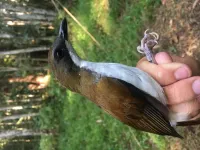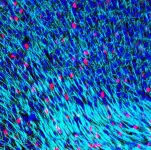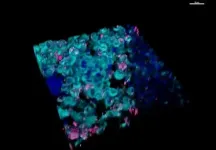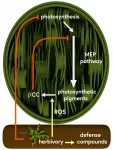(Press-News.org) The mountain forests of Tanzania are more than 9,300 miles away from Salt Lake City, Utah. But, as in eastern Africa, the wild places of Utah depend on a diversity of birds to spread seeds, eat pests and clean up carrion. Birds keep ecosystems healthy. So if birds in Tanzania are in trouble in a warming climate, as found in a recent study by University of Utah researchers, people in Utah as well as in the African tropics should pay attention.
In a new study published in Global Change Biology, doctoral student Monte Neate-Clegg and colleagues tracked the demographics of 21 bird species over 30 years of observations from a mountain forest in Tanzania. For at least six of the species, their population declined over 30 years could be most attributable to rising temperatures--an effect of a warming world. Smaller birds, as well as those that live at the lower part of their elevation range, were at higher risk for slowed population growth.
"If climate change continues to cause population declines in tropical birds, these species could go extinct," Neate-Clegg says. "And what is happening to birds is almost certainly happening to other organisms."
Three decades in Tanzania
This story starts with William Newmark, a conservation biologist at the Natural History Museum of Utah. In 1987, he began collecting data on birds in the East and West Usambara Mountains in northeastern Tanzania. To track the birds, he and his colleagues set up mist nets, nearly invisible nets that safely and temporarily trap birds so that researchers can gently place an identification band (or record a band number if a bird already has one) and release it again.
"Understory tropical birds are also a particularly good group of organisms to assess the impact of climate change on biodiversity because they can be individually banded and thus carefully monitored over time," says Newmark. "Furthermore many tropical understory birds are poor dispersers, and thus they do not have the option to move elsewhere when their environment changes and consequently are excellent indicators of environmental change."
In 2017, Neate-Clegg joined the project, and in 2019 traveled to Tanzania for 10 weeks of fieldwork. "It rained a lot which made things pretty miserable, and the length of isolation was a mental challenge, but good practice for a pandemic!" he says. But the local field team, led by Victor Mkongewa, was fantastic, he says. "They ran a tight ship and made me feel very welcome. Being in the jungle is always a magical experience and I enjoyed exploring the forests and mountains. Having hornbills as an alarm clock never got old!"
Thirty years of bird observations generate a vast and powerful dataset, one that is rare in the tropics. Bird banding is a powerful tool in itself because demographic information for bird species can be derived from the rate at which previously banded birds are re-encountered.
"This dataset was a great opportunity to test for long-term climate signals," Neate-Clegg says. And the location featured high biodiversity and high levels of species that were found in that area and nowhere else. "Historically the forests have been fragmented, and now climate change threatens these species as well," he says. "So it's a really important ecosystem to study, especially given how little research takes place in Africa compared to other tropical locales."
Bird demographics
The researchers examined the resulting data in a few different ways. First, they looked at how the demographics, or population characteristics, of 21 bird species changed over the study period. Specifically, they looked at population growth, including through reproduction, and survival rates.
To explore possible factors behind the trends, the researchers compared demographic trends with precipitation and temperature trends, finding that for more than half of the species studied, the rising temperature was correlated with decreasing population growth rates. After more statistical analysis, they found that temperature explained demographic trends better than just the passage of time for six of the 21 species, or a little more than a quarter.
Neate-Clegg was surprised that precipitation wasn't more of a factor relative to temperature. "Rainfall has been linked to demographic rates in tropical birds in Panama," he says. "More rain means healthier plants, and more insects such as caterpillars, so we expect rain to help bird demographic rates. "On the other hand," says Newmark, "the dry season in the Usambara Mountains is shorter and less pronounced than in Panama and thus there is a less seasonal change in food supply for birds in the Usambara Mountains than in Panama."
Other characteristics emerged as important factors. Birds with smaller bodies exhibited lower population growth, as did birds who lived below the midpoint of their optimal elevation range.
What it means for the rest of the world
The declines in population growth, Neate-Clegg says, are more likely to be due to less reproduction than to bird mortality. "To survive and reproduce birds need to find food and avoid predators and parasites," he says. "If changes in temperature affect any of these processes it could affect the birds." Climate effects on insect abundance, predator activity or fruit timing, he says, could negatively affect birds.
Climate change is a complex global phenomenon, with the potential for winners and losers in various corners of the animal kingdom, Neate-Clegg says.
"Birds trapped in montane forest blocks such as in the Usambara mountains will likely be losers because they live in isolated habitats and so don't really have the option of escaping the temperature increases," he says. "I think montane birds throughout the tropics, and even in temperate places such as the Rockies, will be feeling the pressure of increasing temperatures."
And that matters because birds are not just birds. They're integral components of their ecosystems. In forests particularly, birds participate in seed dispersal and pollination, and their loss threatens the health of forests with all the benefits to soil, air, water and wildlife that they carry. In places like Tanzania, Neate-Clegg adds, biodiversity spurs eco-tourism which supports local economies. "The world," he says, "would be poorer without this diversity."
"This study highlights," Newmark says, "the importance of rapidly developing conservation strategies for tropical birds that incorporate the impact of climate change."
INFORMATION:
Find the full study here.
A new study led by the University of Portsmouth has identified that one of the major factors of age-related brain deterioration is the loss of a substance called myelin.
Myelin acts like the protective and insulating plastic casing around the electrical wires of the brain - called axons. Myelin is essential for superfast communication between nerve cells that lie behind the supercomputer power of the human brain.
The loss of myelin results in cognitive decline and is central to several neurodegenerative diseases, such as Multiple Sclerosis and Alzheimer's disease. This new study found that the cells that drive myelin repair become less efficient as we age and identified a key gene that is most affected by ageing, which reduces the ...
The recent synthesis of one-dimensional van der Waals heterostructures, a type of heterostructure made by layering two-dimensional materials that are one atom thick, may lead to new, miniaturized electronics that are currently not possible, according to a team of Penn State and University of Tokyo researchers.
Engineers commonly produce heterostructures to achieve new device properties that are not available in a single material. A van der Waals heterostructure is one made of 2D materials that are stacked directly on top of each other like Lego-blocks or a sandwich. The van der Waals force, which is an attractive force between uncharged molecules or atoms, holds the materials together.
According to Slava V. Rotkin, Penn State Frontier ...
Intervention research focusing on patients with multiple, simultaneous chronic illnesses is a priority for health organizations such as the National Institutes of Health and Canadian Institutes of Health Research. This is important as physicians seek to better understand how one disease may influence the course of another coexisting one, and how to best care for patients who are battling multiple health issues. Researchers conducted a controlled trial in patients 18 to 80 years with three or more chronic conditions. They collected quantitative data and conducted in-depth interviews with patients, family members and health care providers, then measured the ...
Cooperation is generally a good thing -- working together to reach a goal.
But in the case of cancer, it can be detrimental. University of Cincinnati researchers have discovered that cooperation between two key genes drive cancer growth, spread and treatment resistance in one particularly aggressive type of breast cancer.
The good news is, though, with this knowledge, they can continue to aim their targeted treatments at these genes, singularly and together, to stop breast cancer in its tracks.
This study is published in the March 9 online edition of the journal Cell Reports.
"According to the American Cancer Society's estimate, over 280,000 new cases of invasive breast cancer will be diagnosed in women in 2021," explains Xiaoting Zhang, PhD, professor and Thomas Boat Endowed Chair ...
Some of Princeton's leading cancer researchers were startled to discover that what they thought was a straightforward investigation into how cancer spreads through the body -- metastasis -- turned up evidence of liquid-liquid phase separations: the new field of biology research that investigates how liquid blobs of living materials merge into each other, similar to the movements seen in a lava lamp or in liquid mercury.
"We believe this is the first time that phase separation has been implicated in cancer metastasis," said Yibin Kang, the Warner-Lambert/Parke-Davis Professor of Molecular Biology. He is the ...
Broad political, economic, and social factors influence disciplinary punishment. In particular, over the last half century, such considerations have shaped jurisdictions' use of the death penalty, which has declined considerably since the 1990s. A new study examined the factors associated with use of the death penalty at the county level to provide a fuller picture of what issues influence court outcomes. The study concludes that partisan politics, religious fundamentalism, and economic threat influenced local decisions about the death penalty. The study also found that the size of the African American population, which ...
CHAPEL HILL, NC -- In a viewpoint perspective published in JAMA on March 9, 2021, a University of North Carolina Lineberger Comprehensive Cancer Center researcher and two other experts endorsed the Center for Medicare & Medicaid Services' (CMS) requirement for a patient and their doctor to engage in a shared discussion of benefits and harms before proceeding with a low-dose spiral computed tomography (LDCT) scan as a method for preventing lung cancer death. An accompanying evidence report detailed the benefits and harms from screening, suggesting that shared decision-making between a patient ...
URBANA, Ill. - If you haven't been the parent or caregiver of an infant in recent years, you'd be forgiven for missing the human milk oligosaccharide trend in infant formulas. These complex carbohydrate supplements mimic human breast milk and act like prebiotics, boosting beneficial microbes in babies' guts.
Milk oligosaccharides aren't just for humans, though; all mammals make them. And new University of Illinois research suggests milk oligosaccharides may be beneficial for cats and dogs when added to pet diets.
But before testing the compounds, scientists had to find them.
"When we first looked into this, there had only been one study on milk oligosaccharides in dogs, and none in domestic cats. The closest were really small studies on a single lion and a single ...
In a new study in PNAS, an international team of researchers including scientists from the Max Planck Institute for Chemical Ecology has shown that Arabidopsis thaliana plants produce beta-cyclocitral when attacked by herbivores and that this volatile signal inhibits the methylerythritol 4-phosphate (MEP) pathway. The MEP pathway is instrumental in plant growth processes, such as the production of pigments for photosynthesis. In addition to down-regulating the MEP pathway, beta-cyclocitral also increases plant defenses against herbivores. Since the MEP pathway is only found in plants and microorganisms, but not animals, knowledge of a signal molecule like beta-cyclocitral opens up new possibilities for the development ...
Brazilian researchers who study a native venomous fish have confirmed a route to drug development for the treatment of chronic inflammatory diseases such as multiple sclerosis and asthma.
The venomous toadfish Thalassophryne nattereri contains a peptide (TnP) with anti-inflammatory and anti-allergic potential. Confirmation of this potential has now come via the zebrafish Danio rerio, a popular aquarium species native to South Asia that shares 70% of its genome with humans and is widely used as a model for in vivo trials in drug development.
The researchers tested TnP in D. rerio to measure its toxicity. In a little over a year, their research showed that the peptide is safe. It did not cause cardiac dysfunction or neurological problems in the toxicity tests ...








